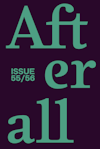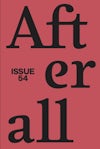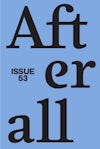
Issue 38
Spring 2015
Issue 38 looks at the appropriation of historical images and narratives in the work of Sharon Hayes, James Richards and R.H. Quaytman. Accompanying essays consider translation as an artistic strategy, the origins of the solo show and the European network L’Internationale.
Editors: Zachary Cahill, Melissa Gronlund, Anders Kreuger, Helena Vilalta, David Morris, Louise O’Hare.
Founding editors: Charles Esche, Mark Lewis.
Table of contents
Foreword
Contextual Essays
- Notes Towards a History of the Solo Exhibition – João Ribas
Artists
Sharon Hayes
- Sharon Hayes Sounds Off
- Our Broken Genres: Sharon Hayes’s Love Addresses – Kris Cohen
James Richards
- Will You Be My Version?: James Richards – Ed Halter
- James Richards: Things Together and Apart – Anders Kreuger
R.H. Quaytman
- R.H. Quaytman: Archive to Ark, the Subjects of Painting – Sarah Ganz Blythe
- R.H. Quaytman: Paratexts and Palimpsests – Richard Birkett
Events, Works, Exhibitions
- The Potential of Plurality: A Discussion with the Directors of L’Internationale – Nathalie Zonnenberg
- Translation’s Gradient – Marcus Verhagen
Foreword
Written by Helena Vilalta
The corruption of bodies is a pledge of their resurrection. Hence, the goal of history is to rediscover in each piece of the past’s flesh the corruptible element par excellence, not the skeleton but the tissue.
— Roland Barthes, Michelet, 1954 1
A ‘queer desire for history’ animates this issue of Afterall — what Carolyn Dinshaw describes as a ‘desire for a different kind of past, for a history that is not straight’. 2 A medievalist scholar, Dinshaw coined this phrase in Getting Medieval: Sexualities and Communities, Pre- and Postmodern (1999) to describe the affective connections that her work attempts to tease out across time, between those on the margins of sexual norms then and now. 3 Although concerned with a more recent past, the artistic practices gathered in these pages also reject a linear understanding of history to embrace a temporality based upon anachronisms, jump cuts and interruptions. Clearly, Dinshaw is not alone in placing an embodied and heterogeneous subject at the centre of current historical enquiries; however, her focus on a tactile notion of history, inspired by Roland Barthes’s account of nineteenth-century historian Jules Michelet’s impulse to touch bodies across history, particularly resonates with the material reassessment of the past invoked in this issue — from the use of montage as a means of bending historical and affective time in works by Sharon Hayes, James Richards and R.H. Quaytman, to critical analyses of the institutional frames through which art history is written and assessed.
Julia Bryan-Wilson brings up Dinshaw’s articulation of a queer temporality in her study of two recent video works by Hayes that use the figure of the sound technician to present the subject as listener rather than viewer. In Parole (2010), an actor records historical and contemporary speeches that reflect upon how sex, race and gender inflect language, whereas in Ricerche: three(2013), it is the artist herself who, after Pier Paolo Pasolini, holds the microphone, asking a group of students about their attitudes towards sex. As Bryan-Wilson notes, listening in these works focuses on both the meaning of language and its materiality as embodied speech: how the words of the past occupy — and affect — present bodies. If these works heighten our capacity to empathise with others, earlier performances have foregrounded the breakdown of reciprocity at a time when virtually all forms of communication have been monetised. In a detailed reading of one of the artist’s ‘love addresses’, in which she recites a letter that folds together stories about love, war and politics, Kris Cohen refers to Hayes’s short-circuiting of communication as a ‘broken genre’ — a term inspired by Fredric Jameson and Lauren Berlant’s conceptions of gender as a social contract.
In using dissonance — the slippage between the words uttered and the body that speaks them, between activist and intimate language — as a form of distancing, Hayes’s practice can be read within a lineage of critical montage. The intervals between images and sounds in Richards’s practice are instead filled with affect; they make materials that are digitally stitched together vulnerable to one another, as in the tradition of lyrical film. Connecting his work to the wandering visions of Stan Brakhage, Maya Deren and Jean Cocteau, Ed Halter considers Richards’s drifting through appropriated images as an attempt not to reflect upon how we have become visually anaesthetised but rather to refashion images and sounds as instruments of communication. In Richards’s viscous media archaeology, Halter remarks, the markers of time on the image’s surface become confounded with the traces of life on the body’s skin, and the history of recent image technologies meets that of queer gestures and codes. Considering how Richards’s own practice has changed over time, Anders Kreuger studies compositional continuities and shifts in his films: from the prevalence of imageless pauses in early works to more recent instances of contrapuntal montage, in which archival and self-generated images and sounds are made to interact freely.
Purchase
The publication is available for purchase. If you would like specific articles only, it is also available individually and to be downloaded as PDFs.
Purchase full publication
Buy via University of Chicago Press
Buy via Central Books
Purchase individual articles
Buy via University of Chicago Press



